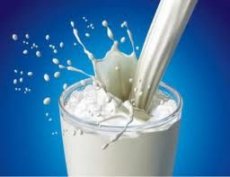Medical expert of the article
New publications
Dairy nutrition and milk intolerance
Last reviewed: 06.07.2025

All iLive content is medically reviewed or fact checked to ensure as much factual accuracy as possible.
We have strict sourcing guidelines and only link to reputable media sites, academic research institutions and, whenever possible, medically peer reviewed studies. Note that the numbers in parentheses ([1], [2], etc.) are clickable links to these studies.
If you feel that any of our content is inaccurate, out-of-date, or otherwise questionable, please select it and press Ctrl + Enter.

Dairy nutrition and milk intolerance
Milk feeding is not an exclusive characteristic of mammals. Milk as a food for newborns was also "invented" by other groups of organisms. Mammalian milk has a remarkable property of maintaining homeostasis in newborn organisms, especially in the first period after birth. It is at this time that the penetration of mother's milk macromolecules into the internal environment of the newborn organism occurs almost unimpeded. This is due to the fact that most newborn mammals have thin skin that is not an immune barrier and unsplit components of milk (including protein) penetrate into their internal environment by endocytosis. Recently, the presence of significant amounts of enzymes and hormones in milk has been discovered, which under these conditions ensures the maintenance of the hormonal status of the newborn. Feeding a newborn with milk from an organism of another species is inadequate from this point of view, since foreign antigens enter the blood.
The main differences between milk and ordinary definitive food are in the composition of carbohydrates. Milk contains a specific carbohydrate, lactose, whereas definitive food contains mainly sucrose and starch. The latter, upon hydrolytic breakdown, is converted mainly into such disaccharides as maltose and isomaltose (but not lactose).
In order to understand the biological role of milk, it is important to keep in mind that the presence of lactose in it, combined with the presence of the corresponding enzyme (lactase) in the mucous membrane of the small intestine, ensures control of the trophic link between mother and offspring. Such a trophic link is broken when the growing organism reaches a certain degree of maturity and lactase in its intestine is repressed. The result is a rapid decrease in milk tolerance and a refusal to consume it. Thus, and this cannot but arouse admiration for the wisdom of nature, one of the most perfect food products - milk - also contains a "limiter" which, under natural conditions, as soon as milk ceases to be vital for the mature offspring, interrupts the mechanism of feeding the offspring that exhausts the mother. It has now been established that the repression of lactase is controlled by the hypothalamic-thyroid axis, the disruption of whose functions prevents the repression of this enzyme.
Milk intolerance
This problem is a special case of food intolerance. However, unlike other types of intolerance, hundreds of millions of people suffer from this one. Thus, milk intolerance (lactose intolerance, lactose malabsorption, lactase deficiency) among the population of Europe and America is 6-12%. Among the inhabitants of the Middle East, it reaches 70% and more. Similar data have been obtained for Cypriots, Japanese, Chinese, Greenland Eskimos, American Indians, Africans, Sri Lankans, etc.
As the body ages, intolerance to milk and a number of other products usually increases. This is due not only to an age-related decrease in the rate of synthesis of various enzymes, including lactase, but also, in particular, to a weakening of the liver barrier functions. In many cases, therapeutic effects on the liver lead to the restoration of food tolerance. Suppression of the intestinal bacterial flora always prevents lactose intolerance. Interestingly, in people with the same lactase deficiency, milk intolerance may be pronounced or absent. This is often determined by differences in the composition of the intestinal bacterial flora (in some people it does not produce toxic metabolites, while in others it produces them in large quantities) and the state of the liver barrier functions.
In recent years, attempts have been made to create milk that can be used by people with lactose intolerance. There are two ways to do this:
- preliminary hydrolysis of lactose before milk is consumed;
- adding lactase enzyme to milk, which breaks down lactose.
In case of lactase deficiency, milk with split lactose is consumed, as well as dairy products with a low content of this disaccharide - kefir, sour milk, cheese, etc.


 [
[